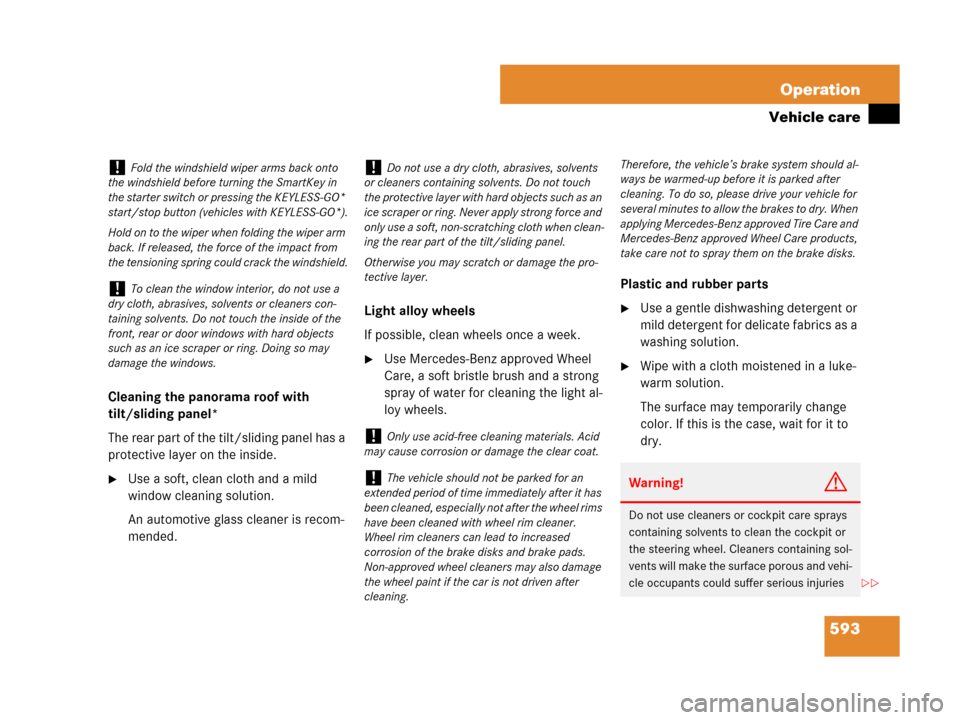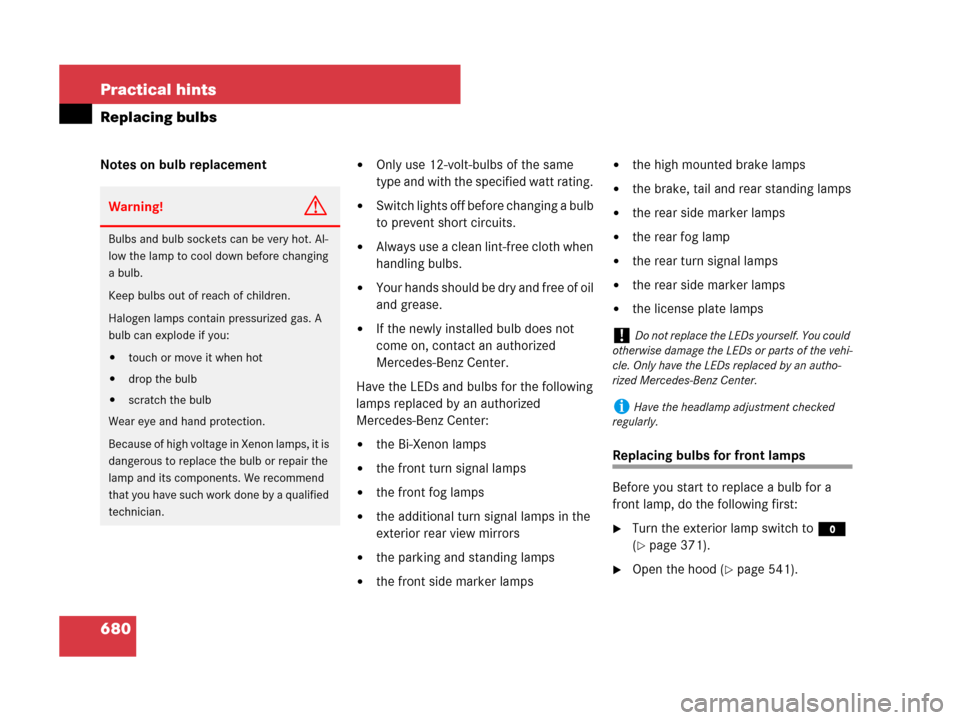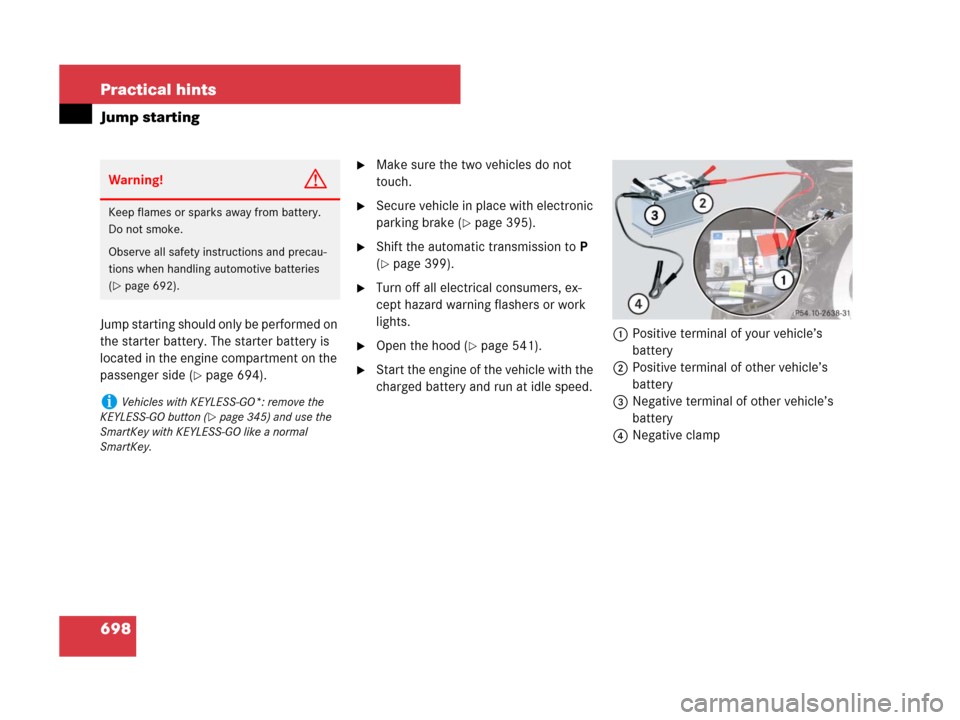Page 594 of 761

593 Operation
Vehicle care
Cleaning the panorama roof with
tilt/sliding panel*
The rear part of the tilt/sliding panel has a
protective layer on the inside.
�Use a soft, clean cloth and a mild
window cleaning solution.
An automotive glass cleaner is recom-
mended.Light alloy wheels
If possible, clean wheels once a week.
�Use Mercedes-Benz approved Wheel
Care, a soft bristle brush and a strong
spray of water for cleaning the light al-
loy wheels.Plastic and rubber parts
�Use a gentle dishwashing detergent or
mild detergent for delicate fabrics as a
washing solution.
�Wipe with a cloth moistened in a luke-
warm solution.
The surface may temporarily change
color. If this is the case, wait for it to
dry.
!Fold the windshield wiper arms back onto
the windshield before turning the SmartKey in
the starter switch or pressing the KEYLESS-GO*
start/stop button (vehicles with KEYLESS-GO*).
Hold on to the wiper when folding the wiper arm
back. If released, the force of the impact from
the tensioning spring could crack the windshield.
!To clean the window interior, do not use a
dry cloth, abrasives, solvents or cleaners con-
taining solvents. Do not touch the inside of the
front, rear or door windows with hard objects
such as an ice scraper or ring. Doing so may
damage the windows.
!Do not use a dry cloth, abrasives, solvents
or cleaners containing solvents. Do not touch
the protective layer with hard objects such as an
ice scraper or ring. Never apply strong force and
only use a soft, non-scratching cloth when clean-
ing the rear part of the tilt/sliding panel.
Otherwise you may scratch or damage the pro-
tective layer.
!Only use acid-free cleaning materials. Acid
may cause corrosion or damage the clear coat.
!The vehicle should not be parked for an
extended period of time immediately after it has
been cleaned, especially not after the wheel rims
have been cleaned with wheel rim cleaner.
Wheel rim cleaners can lead to increased
corrosion of the brake disks and brake pads.
Non-approved wheel cleaners may also damage
the wheel paint if the car is not driven after
cleaning. Therefore, the vehicle’s brake system should al-
ways be warmed-up before it is parked after
cleaning. To do so, please drive your vehicle for
several minutes to allow the brakes to dry. When
applying Mercedes-Benz approved Tire Care and
Mercedes-Benz approved Wheel Care products,
take care not to spray them on the brake disks.Warning!G
Do not use cleaners or cockpit care sprays
containing solvents to clean the cockpit or
the steering wheel. Cleaners containing sol-
vents will make the surface porous and vehi-
cle occupants could suffer serious injuries
��
Page 595 of 761

594 Operation
Vehicle care
Hard plastic trim items
�Use Mercedes-Benz approved Interior
Care, a soft, lint-free cloth and apply
with light pressure.Steering wheel
�Wipe with a damp cloth and dry thor-
oughly or clean with Mercedes-Benz
approved Leather Care.
Carpets
�Use Mercedes-Benz approved Carpet
and Fabric Care for cleaning the car-
pets.Headliner and shelf below rear window
�Use a soft bristle brush or a dry-sham-
poo cleaner in case of excessive dirt.
Seat belts
�Only use clear, lukewarm water and
soap.
from plastic parts coming loose in the event
of air bag deployment.
!Do not use oil, wax or scouring agents on
these parts.
Never apply strong force and only use a soft,
non-scratching cloth when cleaning the surface.
Do not attempt to wipe the surface with a dry
cloth or sponge.
Otherwise you may scratch or damage the sur-
face.
!Never apply strong force and only use a soft,
non-scratching cloth when cleaning the surface.
Do not attempt to wipe the surface with a dry
cloth or sponge.
Otherwise you may scratch or damage the sur-
face.
!The webbing must not be treated with
chemical cleaning agents. Do not dry the web-
bing at temperatures above 176°F (80°C) or in
direct sunlight.
Warning!G
Do not bleach or dye seat belts as this may
severely weaken them. In a crash they may
not be able to provide adequate protection.
��
Page 638 of 761

637 Practical hints
What to do if …?
Display Possible cause/consequencePossible solution
Parking brake
See Oper. ManualIf overheated:
�Let vehicle cool down, and do not engage
electronic parking brake during this time.
or
�Switch ignition off and back on again, and en-
gage or release electronic parking brake.
(USA only)
(Canada only)Parking brake
inoperativeWhen you engage or release the electronic
parking brake, the red indicator lamp for
the electronic parking brake flashes and
goes out after approx. 10 seconds. The yel-
low warning lamp for the electronic parking
brake lights up.
The electronic parking brake is malfunction-
ing.�Switch ignition off and back on again, and en-
gage electronic parking brake (
�page 395).
If the electronic parking brake cannot be en-
gaged:
�Shift the automatic transmission to P
(
�page 399).
�Protect vehicle from rolling away while
parked by using a chock from the vehicle tool
kit (
�page 670).
�Contact an authorized Mercedes-Benz Cen-
ter as soon as possible.
Page 643 of 761
642 Practical hints
What to do if …?
Display Possible cause/consequencePossible solution
STOP,
car too lowYou have started driving although the vehi-
cle level was too low.
The vehicle will be raised. The Airmatic
warning lamp goes out after several sec-
onds.�Stop your vehicle as soon as it is safe to do
so.
�Engage the electronic parking brake
(
�page 395).
�Wait until the message disappears from the
multifunction display.
You may then drive off.
STOP,
car too lowThe Airmatic is malfunctioning.
The Airmatic warning lamp lights up contin-
uously.�Stop and press the vehicle level control but-
ton to select a higher vehicle level
(
�page 440).
�Do not turn steering wheel too far to avoid
damaging the front fenders.
�Listen for scraping noises.
�Do not exceed a speed of 50 mph (80 km/h).
�Contact an authorized Mercedes-Benz
Center as soon as possible.
There is otherwise danger of an accident.
Page 681 of 761

680 Practical hints
Replacing bulbs
Notes on bulb replacement�Only use 12-volt-bulbs of the same
type and with the specified watt rating.
�Switch lights off before changing a bulb
to prevent short circuits.
�Always use a clean lint-free cloth when
handling bulbs.
�Your hands should be dry and free of oil
and grease.
�If the newly installed bulb does not
come on, contact an authorized
Mercedes-Benz Center.
Have the LEDs and bulbs for the following
lamps replaced by an authorized
Mercedes-Benz Center:
�the Bi-Xenon lamps
�the front turn signal lamps
�the front fog lamps
�the additional turn signal lamps in the
exterior rear view mirrors
�the parking and standing lamps
�the front side marker lamps
�the high mounted brake lamps
�the brake, tail and rear standing lamps
�the rear side marker lamps
�the rear fog lamp
�the rear turn signal lamps
�the rear side marker lamps
�the license plate lamps
Replacing bulbs for front lamps
Before you start to replace a bulb for a
front lamp, do the following first:
�Turn the exterior lamp switch to M
(
�page 371).
�Open the hood (�page 541).
Warning!G
Bulbs and bulb sockets can be very hot. Al-
low the lamp to cool down before changing
a bulb.
Keep bulbs out of reach of children.
Halogen lamps contain pressurized gas. A
bulb can explode if you:
�touch or move it when hot
�drop the bulb
�scratch the bulb
Wear eye and hand protection.
Because of high voltage in Xenon lamps, it is
dangerous to replace the bulb or repair the
lamp and its components. We recommend
that you have such work done by a qualified
technician.
!Do not replace the LEDs yourself. You could
otherwise damage the LEDs or parts of the vehi-
cle. Only have the LEDs replaced by an autho-
rized Mercedes-Benz Center.
iHave the headlamp adjustment checked
regularly.
Page 690 of 761

689 Practical hints
Flat tire
Removing the wheel
1Alignment bolt
�Unscrew upper-most wheel bolt and
remove.
�Replace this wheel bolt with alignment
bolt1 supplied in the tool kit.
�Remove the remaining bolts.
�Remove the wheel.Attaching the spare wheel
1Wheel bolt for light alloy rims and
Minispare wheel with light alloy rim
2Wheel bolt for Minispare wheel with
steel rim (located in trunk with spare
wheel)
!Do not place wheel bolts in sand or dirt. This
could result in damage to the bolt and wheel hub
threads.
Warning!G
Always replace wheel bolts that are dam-
aged or rusted.
Never apply oil or grease to wheel bolts.
Damaged wheel hub threads should be re-
paired immediately. Do not continue to drive
under these circumstances! Contact an au-
thorized Mercedes-Benz Center or call
Roadside Assistance.
Incorrect wheel bolts or improperly tight-
ened wheel bolts can cause the wheel to
come off. This could cause an accident.
Make sure you are using the correct wheel
bolts.
Warning!G
Only use Genuine Mercedes-Benz wheel
bolts. Other wheel bolts may come loose.
Do not tighten the wheel bolts when the ve-
hicle is raised. Otherwise the vehicle could
fall off the jack.
Page 691 of 761

690 Practical hints
Flat tire
�Clean contact surfaces of wheel and
wheel hub.
�Guide the spare wheel onto the align-
ment bolt and push it on.
�Insert wheel bolts and tighten them
slightly.
�Unscrew the alignment bolt, install the
last wheel bolt and tighten slightly.Lowering the vehicle
�Lower vehicle by turning crank coun-
terclockwise until vehicle is resting ful-
ly on its own weight.
�Remove the jack.
1 - 5 Wheel bolts
!Wheel bolts2 must be used when mount-
ing a Minispare wheel with steel rim. The use of
any wheel bolts other than wheel bolts2 for a
Minispare wheel with steel rim will physically
damage the vehicle’s brakes.
Wheel bolts1 must be used when mounting a
Minispare wheel with light alloy rim. The use of
any wheel bolts other than wheel bolts1 for
a Minispare wheel with light alloy rim will physi-
cally damage the vehicle’s brakes.
Warning!G
Make sure to use the original length wheel
bolts when remounting the original wheel
after it has been repaired.!To avoid paint damage, place wheel flat
against hub and hold it there while installing first
wheel bolt.
Page 699 of 761

698 Practical hints
Jump starting
Jump starting should only be performed on
the starter battery. The starter battery is
located in the engine compartment on the
passenger side (
�page 694).
�Make sure the two vehicles do not
touch.
�Secure vehicle in place with electronic
parking brake (
�page 395).
�Shift the automatic transmission toP
(
�page 399).
�Turn off all electrical consumers, ex-
cept hazard warning flashers or work
lights.
�Open the hood (�page 541).
�Start the engine of the vehicle with the
charged battery and run at idle speed.1Positive terminal of your vehicle’s
battery
2Positive terminal of other vehicle’s
battery
3Negative terminal of other vehicle’s
battery
4Negative clamp
Warning!G
Keep flames or sparks away from battery.
Do not smoke.
Observe all safety instructions and precau-
tions when handling automotive batteries
(
�page 692).
iVehicles with KEYLESS-GO*: remove the
KEYLESS-GO button (
�page 345) and use the
SmartKey with KEYLESS-GO like a normal
SmartKey.